
Cannabis Harms Young Brains
Don’t let youth get high on your supply.
Keep it secure.
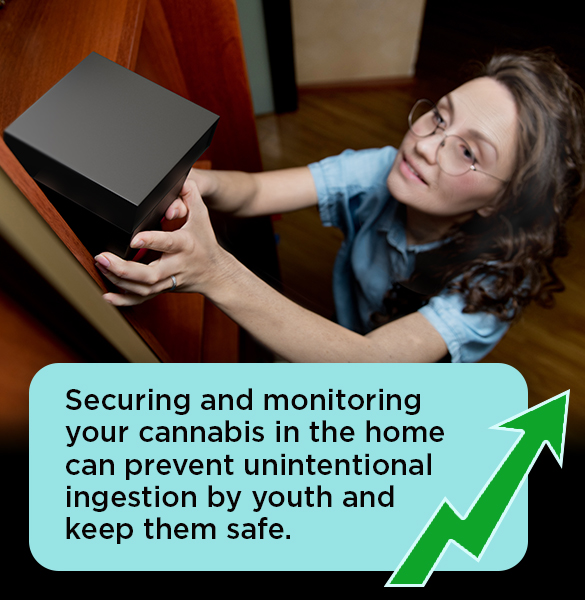
Driving High IS Impaired Driving
Don’t drive high.
Get a ride.
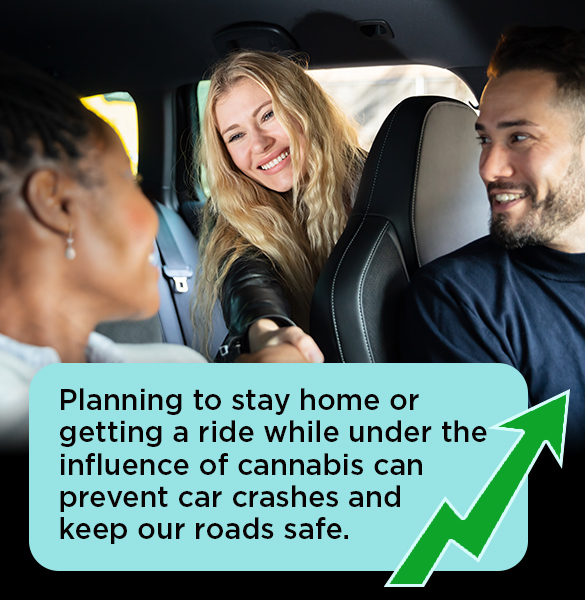
Suffolk County-based Town of Babylon Cares partnered with Nassau County-based PACT/YES to create a cross-county cannabis awareness campaign to help keep youth and our communities safe. Multiple sectors of community partners contributed to the creation of the campaign to make sure it resonates with all community members throughout Long Island, New York.
| Top 10 Things to Know about Cannabis | |
 | Cannabis is only legal in New York State for those 21 years of age or older, meaning those under the age of 21 cannot legally possess or consume cannabis. |
 | Cannabis potency has been steadily increasing over the last few decades.1 |
 | Accidental ingestion (and over-ingestion) of cannabis is related to multiple factors, including the sale of cannabis products with high levels of THC and the consumers’ confusion regarding the labeling of cannabis products, which disproportionately impacts new or inexperienced users.2 |
 |
States that decriminalized adult cannabis use have shown increased emergency department visits and regional poison center cases for unintentional pediatric cannabis exposures.3 |
 | Consuming edibles results in a delayed and often unpredictable onset and duration of psychotropic effects due to the slower absorption of THC.2 |
 | It is illegal to drive under the influence of cannabis due to its effects on cognitive performance that have been associated with an increased risk for motor vehicle collisions.2 You can be charged with a DUI and are subject to the same penalties as driving under the influence of alcohol. |
 | The burning of cannabis by anyone in a vehicle is illegal under the Open Container Law. |
 | Several sources suggest that following initial use, cannabis consumers should wait for a minimum of 3–4 hours before attempting to drive (most driving studies performed on inhaled cannabis in younger subjects*).4 |
 | Evidence suggests that cannabis decriminalization, medical legalization, and recreational legalization may be associated with increases in cannabis positivity among drivers.5 |
 | Among the 15% of American adults who use cannabis each year, nearly 1 in every 3 report driving under the influence.6 |
It is Important to Secure and Monitor your Cannabis

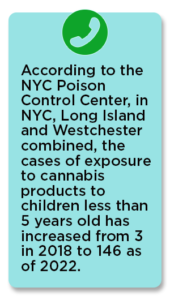 According to the New York City Poison Control Center, in NYC, Long Island and Westchester combined, the cases of exposure to cannabis products to children less than 5 years old has increased from 3 in 2018 to 146 as of 2022.7 Accidentally consuming edibles is a risk for children and pets that can result in cannabis toxicity or the need for emergency medical attention.8 Children may become very sick and have difficulty sitting up, standing or breathing.9
According to the New York City Poison Control Center, in NYC, Long Island and Westchester combined, the cases of exposure to cannabis products to children less than 5 years old has increased from 3 in 2018 to 146 as of 2022.7 Accidentally consuming edibles is a risk for children and pets that can result in cannabis toxicity or the need for emergency medical attention.8 Children may become very sick and have difficulty sitting up, standing or breathing.9
If a child has had accidental exposure to cannabis or cannabis products of any kind, call the Poison Control Center at (800) 222-1222 or visit your local emergency room. Contact your vet immediately if your pet has ingested a cannabis-containing product.
Health Impact on Youth and Young Adults
Certain compounds in cannabis like THC can affect the brain in ways that can impact behavior, mood, thoughts or perceptions, and can be intoxicating.8 It is important to recognize that intoxication can be felt differently in different people and depends on the type of cannabis product being consumed, how much is being consumed and whether someone is new to consuming cannabis. The intoxicating effects of cannabis consumed in edibles or beverages can be delayed and may not be fully felt until four or more hours after consumption.8
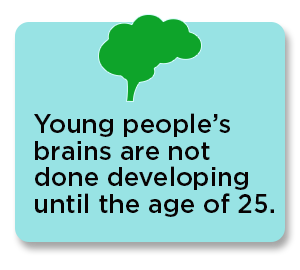 Cannabis can be harmful to growing brains and have long-term health and social impacts. THC in cannabis can affect the developing brain. The part of the brain that is responsible for making decisions (the prefrontal cortex) is one of the last parts of the brain that develops and is particularly impacted by cannabis use.8,10 Young people’s brains are not done developing until the age of 25. Negative cognitive effects can include difficulty thinking and solving problems, problems with memory and learning, reduced coordination, difficulty maintaining attention, and problems with school and social life after consistent consumption.8,10
Cannabis can be harmful to growing brains and have long-term health and social impacts. THC in cannabis can affect the developing brain. The part of the brain that is responsible for making decisions (the prefrontal cortex) is one of the last parts of the brain that develops and is particularly impacted by cannabis use.8,10 Young people’s brains are not done developing until the age of 25. Negative cognitive effects can include difficulty thinking and solving problems, problems with memory and learning, reduced coordination, difficulty maintaining attention, and problems with school and social life after consistent consumption.8,10
TIPS TO KEEP CANNABIS SECURE
If you intend to use cannabis, be sure it is kept in a safe place. Take these steps to help prevent children and pets from accessing cannabis:
- Obtain a lockable storage center to keep your cannabis, INCLUDING cannabis-infused foods and candies.
- Keep cannabis products in a high place, out of reach of children.
- Do not leave cannabis products out when not in use.
Cannabis Harms Young Brains: Don’t let youth get high on your supply. Keep it secure.
Driving While Under the Influence of Cannabis is Impaired Driving

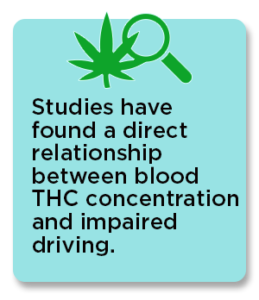 According to the Institute for Traffic Management and Research:
According to the Institute for Traffic Management and Research:
- In 2018 in New York State, there were 314 fatalities for motor vehicle crashes that were related to drugs not including alcohol.12
- In 2020 in New York State, there were 3,931 impaired driving crashes and 27,268 impaired driving arrests.13
Cannabis should always be consumed responsibly, and never before driving or operating heavy machinery.
The rule of thumb is: if you feel different, you will drive different.8
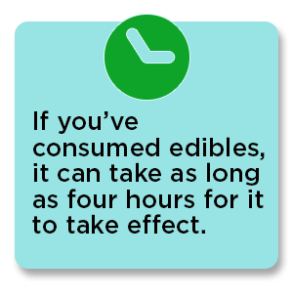
Studies have found a direct relationship between blood THC concentration and impaired driving.14 Often cannabis is combined with alcohol, further increasing the risk of crashes. And remember, if you’ve consumed edibles, it can take as long as four hours for it to take effect. If you’re not sure if you’re high or impaired, stay put, and don’t take the chance of harming yourself or others by driving.
TIPS FOR PREVENTING IMPAIRED DRIVING
If you intend to drive, the safest option is not to use cannabis. Take these steps to help prevent impaired driving if you plan to use, are using or have used cannabis:
- Remain home when you consume cannabis, or plan to stay where you are using for a few hours or overnight.
- Make a plan to get a ride home from someone who has not been drinking alcohol and/or using drugs.
- Decide not to drive and remind your friends and family to do the same if they have consumed cannabis.
- Choose a trusted designated driver who will not use cannabis when you are going out with a group of people you know.
- Use a rideshare service, call a taxi or use another form of public transportation.
Driving High IS Impaired Driving: Don’t drive high. Get a ride.
For more information:
https://www.cadca.org/resources/practical-theorist-12-cannabis-current-state-affairs
https://www.cdc.gov/marijuana/index.htm
Important phone numbers:
UPSTATE POISON CONTROL – 1 (800) 222-1222
NYS – (212) P-O-I-S-O-N-S
Sources
- ElSohly, M. A., Mehmedic, Z., Foster, S., Gon, C., Chandra, S., & Church, J. C. (2016). Changes in Cannabis Potency Over the Last 2 Decades (1995-2014): Analysis of Current Data in the United States. Biological psychiatry, 79(7), 613–619. https://doi.org/10.1016/j.biopsych.2016.01.004
- Matheson J., Le Foll B. (2020). Cannabis Legalization and Acute Harm From High Potency Cannabis Products: A Narrative Review and Recommendations for Public Health. Frontiers in psychiatry, 11:591979. https://doi.org/10.3389/fpsyt.2020.591979
- Wang, GS., et al. (2016). Unintentional Pediatric Exposures to Marijuana in Colorado, 2009-2015. JAMA Pediatrics 170(9). https://doi:10.1001/jamapediatrics.2016.0971
- Pearlson, G.D., Stevens M.C., D’Souza D.C.. (2021). Cannabis and Driving. Frontiers in Psychiatry 12:689444. doi: 10.3389/fpsyt.2021.689444
- Windle, S.B., Socha, P., Nazif-Munoz, J.I., Harper, S., Nandi, A. (2022). The Impact of Cannabis Decriminalization and Legalization on Road Safety Outcomes: A Systematic Review. American Journal of Preventive Medicine, 63(6), pages 1037-1052. https://doi.org/10.1016/j.amepre.2022.07.012
- Salas-Wright, C.P., Cano, M., Hai, A. H., Oh, S., & Vaughn, M. G. (2021). Prevalence and Correlates of Driving Under the Influence of Cannabis in the U.S. American journal of preventive medicine, 60(6) pages 251–260. https://doi.org/10.1016/j.amepre.2021.01.021
- (2022, October 11). Poison Control Data.
- Office of Cannabis Management. (n.d.). Adult use. Office of Cannabis Management. Retrieved December 28, 2022, from https://cannabis.ny.gov/adult-use
- Centers for Disease Control and Prevention. (2020, October 19). Marijuana and Public Health- Poisoning. Centers for Disease Control and Prevention. Retrieved December 28, 2022, from https://www.cdc.gov/marijuana/health-effects/poisoning.html
- Center for Disease Control and Prevention. (2021, September 8). Marijuana and Public Health- Teens. Centers for Disease Control and Prevention. Retrieved December 28, 2022, from https://www.cdc.gov/marijuana/health-effects/teens.html
- Practical_theorist_12_cannabis_the_current_state_of_affairs_final.pdf (cadca.org)
- Institute for Traffic Safety Management and Research. (2021, November). New York State Fact Sheet on drug -related fatal & personal injury crashes*. Institute for Traffic Safety Management and Research. Retrieved December 28, 2022, from https://www.itsmr.org/wp-content/uploads/2022/01/Drug-Crashes-2016-2020-FINAL-Nov-2021.pdf
- Institute for Traffic Management and Research. (2021 ). New York State Fact Sheet on Aggravated DWI (ADWI): 2018 – 2020 (TSLED). Institute for Traffic Management and Research. Retrieved December 28, 2022, from https://www.itsmr.org/wp-content/uploads/2022/01/Aggravated-2018-2020-Dec-2021.pdf
- 2022, April 15. Does marijuana use affect driving?. Retrieved from https://nida.nih.gov/publications/research-reports/marijuana/does-marijuana-use-affect-driving on 2022, December 28
